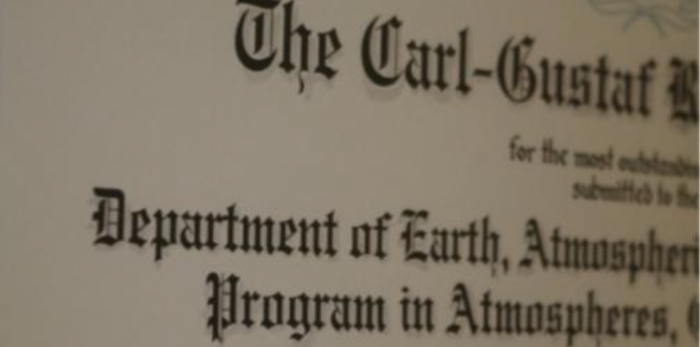Featured Stories, MIT, MIT EAPS, News | January 6, 2018
Nicholas Hawco PhD ’17 Receives the 2017 Rossby Award

By Lauren Hinkel
The Program in Atmospheres, Oceans and Climate (PAOC) in the Department of Earth, Atmospheric and Planetary Sciences (EAPS) congratulates Nicholas J. Hawco, a 2017 PhD graduate of the MIT-Woods Hole Oceanographic Institution (WHOI) Joint Program in oceanography, on winning the Rossby Award for best doctoral thesis done the preceding year within the program.
The award is named after MIT Professor Carl-Gustaf Rossby, the founder of meteorology and physical oceanography studies at the institute and a key figure in the field’s global development. This became the basis the first Department of Meteorology in the United States, and later evolved into the current Program in Atmospheres, Oceans and Climate within the Department of Earth, Atmospheric and Planetary Sciences. Rossby is also considered a pioneer in modern dynamics of the atmosphere and ocean. Some of his seminal contributions to the field include identifying and characterizing the jet stream and the long waves in the westerlies that were later named planetary waves or Rossby waves. Rossby’s work explained large-scale physics using fluid dynamics, deriving the Rossby number and the Rossby radius of deformation, which are fundamental to research today. The honor recognizes excellence in the next generation of scientists with a cash award and his name will appear on a plaque in the department.

Advised by WHOI’s Mak Saito, Hawco’s work on “The Cobalt Cycle in the Tropical Pacific Ocean” illuminated an often overlooked and potentially crucial part of ocean biogeochemistry: the cobalt cycle. As the central atom in vitamin B12, cobalt is important for metabolism, DNA synthesis, and its uptake by primary producers like phytoplankton is critical to the marine ecosystem. However, its status as a growth-limiting nutrient in seawater, like nitrogen, phosphorus and other trace metals, was uncertain due scant and difficult to obtain data. But as Hawco remarks, we’re in a scientific phase when investigating metals like cobalt and their biological effect is possible.
“Cobalt is the most scarce nutrient in the oceans,” Hawco says. “It occurs in the lowest concentrations, so that was a clue for us that there might be some biological control on the amount of phytoplankton that can grow in the oceans based on the cobalt supply to the ocean.” To examine this, he assessed cobalt sources, physical and chemical interactions in seawater before being taken up by phytoplankton, and biological requirements of a phytoplankton species known to flourish in nutrient-limited conditions. Samples and data from the Tropical Pacific Ocean onboard GEOTRACES cruises showed that cobalt plumes often occurred in oxygen-poor waters, like off the coast of Peru and Mexico. In these cobalt “hotspots,” Hawco found different seawater chemistry: Cobalt oxidation and scavenging reactions were limited by the absence of oxygen, leaving cobalt more biologically available. Additionally, most of the cobalt that entered the ocean did so via land runoff into rivers; other sources like dust deposition by the winds contributed a small fraction. But, because of the chemical reactions occurring in oxygen-rich oceans, the major supply of available oceanic cobalt arrived through these oxygen-poor regions with high efficiency. These low oxygen regions represent over 25% of the global supply, driving the cobalt cycle to turn over quickly, about every 50 years, similar to the scale for iron, a growth-limiting nutrient.
Hawco then compared this quantity to the minimum requirements of a Prochlorococcus strain isolated from the Equatorial Pacific. Using culture experiments, he found that only 20 atoms of cobalt per cell were needed for the organism to grow, which he describes as “mind-blowing.” Hawco also discovered through a fortunate accident that zinc and manganese, which occur at higher concentrations in seawater than cobalt, competitively inhibit phytoplankton growth, since the organism cannot easily distinguish between these elements. This confusion may have driven Prochlorococcus to evolve ways to obtain cobalt from other partially degraded, organic complexes, like phytoplankton remineralization, in seawater. From here, he looked at the quantity of phytoplankton in the open ocean and could estimate how much cobalt has been acquired, noting that it was close to being limited.
“There’s something really intriguing about the connection between inorganic materials and organic life,” he says, reflecting on his research. “Once I got to MIT and WHOI, it was a great way for me to put this interaction in context: How much cobalt do they need? Why do they need it? How much is there? I really like the tension between these large scale supplies that could change relatively quickly…and how that manifests on a small scale.”
It is for this work that the Carl-Gustaf Rossby Prize Committee, EAPS professors Tim Cronin, Dan Cziczo and Glenn Flierl, nominated Hawco for the honor. “Nick’s thesis, The Cobalt Cycle in the Tropical Pacific Ocean, included data from new, full-depth sections across the Pacific, which he then used to reinterpret the global cobalt cycle. His [thesis] committee regarded this as innovative work, which will become a seminal paper in marine geochemistry. Indeed, the chair of his committee, [WHOI’s] Tristan Horner, comments that committee members compared this work favorably to Broecker and Peng’s Tracers in the Sea.” Tracers in the Sea is considered by many oceanographers to be foundational for the study of ocean chemistry.
Now, Hawco is a postdoc at USC studying the role of biogeochemical iron cycling in the Pacific. He sees his PhD work as a stepping-stone for others to investigate the cobalt cycle’s importance. “Cobalt is a niche topic in terms of chemistry and ocean productivity, so a lot of people who study phytoplankton don’t have cobalt on their minds.” But he perceives this work to be an accessible avenue into its consideration and, in the future, would like to revisit the topic, along with other trace metal cycles, in his own lab. “This is definitely something that I hope more people think about and I hope this work is a gateway.”




